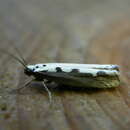pt-BR
nomes no trilho de navegação


Ethmia bipunctella ist ein Schmetterling (Nachtfalter) aus der Familie der Grasminiermotten (Elachistidae).
Die Falter erreichen eine Flügelspannweite von 19 bis 28 Millimeter.[1] Sitzende Falter rollen die Flügel um den Körper herum. Die costale Hälfte der Vorderflügel ist schwarz, die andere Hälfte einschließlich des Flügelinnen- und Außenrandes ist weiß. Der Verlauf der Grenzlinie zwischen schwarzem und weißem Bereich ist nur wenig variabel. Das Schwarz erreicht in der Mitte den Flügelaußenrand, der Innenwinkel ist weiß. Eine Reihe schwarzer Striche verläuft entlang der Saumlinie. Von oben gesehen befinden sich auf beiden Seiten des Thorax drei schwarze Punkte.[2]
Ethmia bipunctella ist in Europa und Nordamerika verbreitet.[2][3]
Die Raupen leben in feinen Gespinsten und fressen an den Blüten und Blättern von Gewöhnlichem Natternkopf (Echium vulgare), Gewöhnlicher Hundszunge (Cynoglossum officinale)[2][1] und anderen Arten von Raublattgewächsen. Dazu zählen Arten aus den Gattungen Anchusa, Cynoglossum, Echium, Lithospermum, Symphytum.[3] Die Raupen verpuppen sich in abgestorbenen Stängeln oder verrottendem Holz. Die Art bildet zwei Generationen im Jahr, die von Ende April bis Ende Juni und von August bis September fliegen. Die Falter kommen ans Licht.[4]
Aus der Literatur sind folgende Synonyme bekannt:[5]
Ethmia bipunctella ist ein Schmetterling (Nachtfalter) aus der Familie der Grasminiermotten (Elachistidae).
Ethmia bipunctella is a diurnal moth from the family Depressariidae. It can be found in Central and Southern Europe, North Africa, Asia and the northeastern part of North America. E. iranella was formerly included here as a subspecies.
The wingspan of the moth ranges from 19–28 millimetres (0.75–1.10 in). The flight time ranges from May to September. The moth is bivoltine, having two generations per year.
The most important host plant is the viper's bugloss, but also Anchusa officinalis and plants from the genus Symphytum. Pupae are attached to dead wood.
Ethmia bipunctella is a diurnal moth from the family Depressariidae. It can be found in Central and Southern Europe, North Africa, Asia and the northeastern part of North America. E. iranella was formerly included here as a subspecies.
 Caterpillar
Caterpillar The wingspan of the moth ranges from 19–28 millimetres (0.75–1.10 in). The flight time ranges from May to September. The moth is bivoltine, having two generations per year.
The most important host plant is the viper's bugloss, but also Anchusa officinalis and plants from the genus Symphytum. Pupae are attached to dead wood.
Ethmia bipunctella est une espèce de lépidoptères (papillons) de la famille des Depressariidae et de la sous-famille des Ethmiinae.
Il vit en Europe centrale et du sud, en Asie, en Afrique du Nord et au nord-est de l'Amérique du Nord.
Il a une envergure de 19 à 28 mm. Il vole de juin à septembre selon les endroits sur deux générations.
Sa chenille se nourrit sur la Vipérine commune mais aussi sur la Buglosse officinale et sur d'autres plantes du genre Consoude.
De grote zwartwitmot (Ethmia bipunctella) is een dagactieve vlinder uit de familie grasmineermotten (Elachistidae). De spanwijdte bedraagt tussen de 19 en 28 millimeter.
Van mei tot en met september vliegen twee generaties. De belangrijkste waardplant van de rups is slangenkruid, maar ook gewone ossentong en planten uit het geslacht smeerwortel worden gebruikt. Het verpoppen vindt plaats in dood hout.
Het verspreidingsgebied beslaat Centraal- en Zuid-Europa, Noord-Afrika, Klein-Azië en het Noordoostelijke deel van Noord-Amerika. In Nederland en België is deze vlinder zeldzaam.
De grote zwartwitmot (Ethmia bipunctella) is een dagactieve vlinder uit de familie grasmineermotten (Elachistidae). De spanwijdte bedraagt tussen de 19 en 28 millimeter.
Van mei tot en met september vliegen twee generaties. De belangrijkste waardplant van de rups is slangenkruid, maar ook gewone ossentong en planten uit het geslacht smeerwortel worden gebruikt. Het verpoppen vindt plaats in dood hout.
Het verspreidingsgebied beslaat Centraal- en Zuid-Europa, Noord-Afrika, Klein-Azië en het Noordoostelijke deel van Noord-Amerika. In Nederland en België is deze vlinder zeldzaam.
Ethmia bipunctella é uma espécie de insetos lepidópteros, mais especificamente de traças, pertencente à família Elachistidae.[1]
A autoridade científica da espécie é Johan Christian Fabricius, tendo sido descrita no ano de 1775.
Trata-se de uma espécie presente no território português.
Ethmia bipunctella é uma espécie de insetos lepidópteros, mais especificamente de traças, pertencente à família Elachistidae.
A autoridade científica da espécie é Johan Christian Fabricius, tendo sido descrita no ano de 1775.
Trata-se de uma espécie presente no território português.
Blåeldssorgmal,[1] Ethmia bipunctella[1][2] är en fjärilsart som först beskrevs av Johan Christian Fabricius 1775. Blåeldssorgmal ingår i släktet Ethmia, och familjen Ethmiidae.[1][2][3] Arten är reproducerande i Sverige.[1] Inga underarter finns listade i Catalogue of Life.[2]
Blåeldssorgmal, Ethmia bipunctella är en fjärilsart som först beskrevs av Johan Christian Fabricius 1775. Blåeldssorgmal ingår i släktet Ethmia, och familjen Ethmiidae. Arten är reproducerande i Sverige. Inga underarter finns listade i Catalogue of Life.
Ethmia bipunctella là một loài là một loài bướm đêm hoạt động suốt ngày thuộc họ Ethmiidae. Nó có thể được tìm thấy ở Trung và Nam Âu, Bắc Phi, châu Á and phần đông bắc của Bắc Mỹ. E. iranella trước đây nằm trong loài này ở dạng phụ loài.
Sải cánh dài 19–28 milimét (0,75–1,10 in). Bướm bay từ tháng 5 đến tháng 9.
Chúng ăn chủ yếu là loài Viper's Bugloss, nhưng cũng ăn Anchusa officinalis và các cây thuộc chi Symphytum.
Phương tiện liên quan tới Ethmia bipunctella tại Wikimedia Commons
Ethmia bipunctella là một loài là một loài bướm đêm hoạt động suốt ngày thuộc họ Ethmiidae. Nó có thể được tìm thấy ở Trung và Nam Âu, Bắc Phi, châu Á and phần đông bắc của Bắc Mỹ. E. iranella trước đây nằm trong loài này ở dạng phụ loài.
Sải cánh dài 19–28 milimét (0,75–1,10 in). Bướm bay từ tháng 5 đến tháng 9.
Chúng ăn chủ yếu là loài Viper's Bugloss, nhưng cũng ăn Anchusa officinalis và các cây thuộc chi Symphytum.